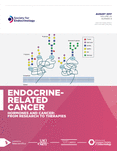WOMEN IN CANCER THEMATIC REVIEW: Diverse functions of DNA methylation: implications for prostate cancer and beyond
- Correspondence should be addressed to A H Ting; Email: tinga{at}ccf.org
-
Figure 1
The cycle of DNA methylation addition and removal. A model for how DNA methylation is added and removed from the 5th position of cytosine is presented. Clockwise from cytosine: cytosine is converted to methylcytosine by DNA methyltransferases (DNMTs), and demethylated by successive conversion to hydroxymethylcytosine then formylcytosine or carboxycytosine carried out by ten-eleven translocation (TET) methylcytosine dioxygenases. Then as part of the base excision repair pathway, thymine-DNA glycosylase (TDG) excises formylcytosine or carboxycytosine from the DNA. The DNA is repaired with an unmodified cytosine to complete the demethylation cycle.
-
Figure 2
DNA methylation has diverse gene regulatory functions depending upon genomic context. A simplified model of the genome is depicted at the top (green box). The yellow rectangles are exons of a generic mRNA-producing gene, and the black lines between exons are introns. Thin yellow exonic regions correspond to untranslated regions (UTR) of mRNA, and thick yellow exonic regions correspond to protein coding mRNA sequences. The black lines outside of the genic region depict intergenic DNA. Within each genomic context, the first row below indicates known, context-specific functions of DNA methylation on mRNA expression (light green box). The second row below indicates how these effects on mRNA expression translate to altered protein expression (pink box). It is important to note that this figure does not imply evidence exists for each of these mechanisms specifically in prostate cancer. Instead, it serves to summarize known functions of DNA methylation studied in a wide range of biological systems and suggests that prostate cancer-specific DNA methylation found in each of these contexts may function through some or all of these mechanisms.
- © 2016 Society for Endocrinology












